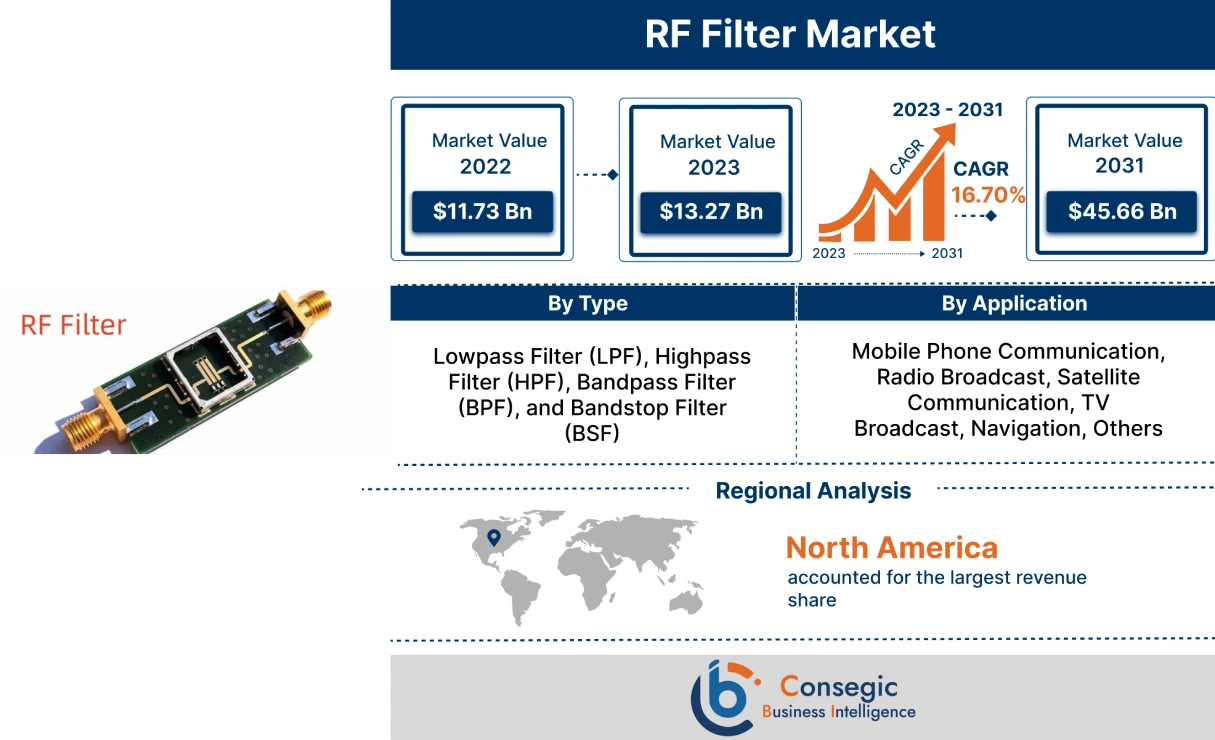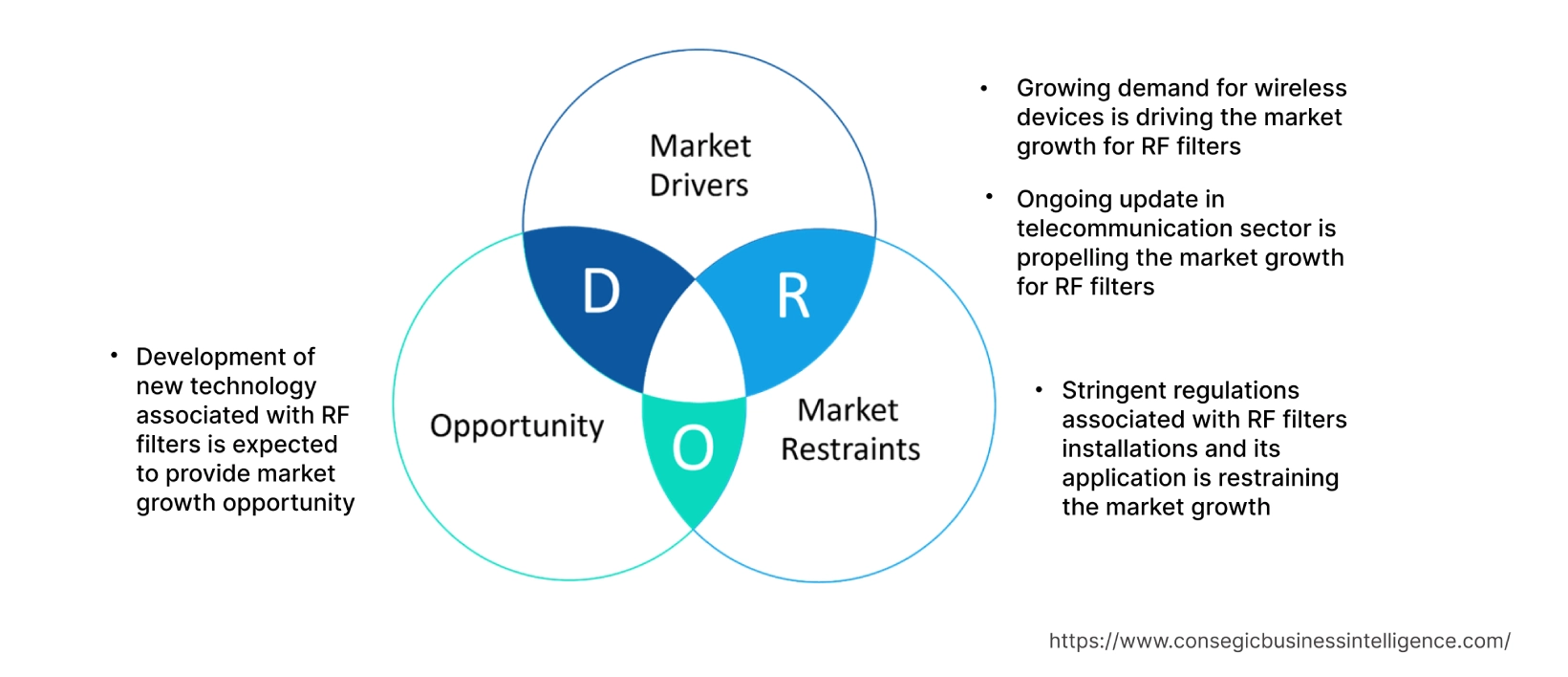RF Filter Market Size :
RF Filter Market size is estimated to reach over USD 45.66 Billion by 2031 from a value of USD 11.73 Billion in 2022 and is projected to grow by USD 13.27 Billion in 2023, growing at a CAGR of 16.70% from 2023 to 2031.
RF Filter Market Scope & Overview :
An RF filter is a passive form of filter designed to receive radio frequencies and allows to pass signals within a specified frequency band and reject signals outside of the band. They are used in a wide variety of applications, including radio receivers, transmitters, cellular phones, radar systems, and microwave ovens. Moreover, the frequency band that is allowed to pass through the filter is called the passband. The frequency band that is blocked by the filter is called the stopband.
RF Filter Market Insights :
RF Filter Market Dynamics - (DRO) :
Key Drivers :
Growing demand for wireless devices is driving the market growth for RF filters
The demand for wireless devices is growing rapidly, due to the increasing popularity of smartphones, tablets, laptops, Wi-Fi routers, and other wireless devices. The aforementioned devices utilize these filters to remove unwanted signals and noise, thus ensuring that the signal being transmitted or received is clear and reliable. Accordingly, as the need for wireless devices continues to grow, the market is also growing which is ultimately driving the RF filter market share. Since these filters are essential components of wireless communication systems, they are increasingly being used to provide proper and noise-free communications.
Moreover, according to the analysis, the key factors attributing to the segment growth include their application in cellular phones, satellite receivers, radar systems, and Wi-Fi routers. For instance, in a cellular phone, an RF filter is used to select the signal from the cell tower and the phone. Whereas, in a Wi-Fi router, it is used to select the signal from the wireless network and the router. Therefore, owing to the aforementioned applications in communicating wirelessly through various signals transmitting devices are driving the RF filter market growth.
Ongoing updates in the telecommunication industry are propelling the RF filter market
The telecom industry is presently growing with major technological developments from 4G communication services to 5G. RF filters are therefore increasingly being used in telecommunication equipment for providing better network and voice services. The key reasons are to growing demand for minimizing interference between different signals and protecting the network from damage caused by strong signals or noise, among others. In a 5G base station, they are used to select the signal from the mobile devices that are connected to the base station. Thus, it allows the base station to receive the signals from the devices that it is supposed to communicate with, and it blocks out any unwanted signals.
In addition, the analysis also shows that 5G mobile devices are used to protect the device from damage caused by strong signals or noise generated by the base stations. Furthermore, they are used to minimize interference between different signals, as there are high chances of signal degradation which impacts the performance of the network. Accordingly, they help to minimize interference by blocking unwanted signals, ensuring that the desired signals are transmitted and received without interference.
For instance, the Ookla 5G Map illustrates that the total number of 5G deployments reached 112 countries in November 2021, up by 13% from 99 countries in November 2020. Additionally, Ookla reported that the total number of 5G deployments increased significantly to 85,602 in 2021, up from 17,428 in 2020. Accordingly, analysis shows that, owing to the technological adaptation in the network in the telecommunication industry thus boosting the RF filter market growth and trends.
Key Restraints :
Stringent regulations associated with installations and their application are restraining the RF filter market
The regional and country-based governments have introduced several regulations and laws for the proper application of these filters on electronic devices. Moreover, regulations force the manufacturers and end-users to manufacture and utilize these filters as per specified limits respectively. Regulations such as Electromagnetic compatibility (EMC), are designed to prevent electronic devices from emitting or interfering with radio waves. They are often used to comply with EMC regulations, however, there is an additional cost and complexity incurred by the device.
For instance, the Federal Communications Commission (FCC), the United States's primary regulatory agency for communications has set regulations that are applied to these filters. FCC Part 15, regulation applies to unintentional radiators. It limits the amount of radio frequency (RF) energy that an unintentional radiator can emit. Similarly, FCC Part 18, regulation applies to intentional radiators, such as RF transmitters. It specifies the requirements for the design and testing of intentional radiators. Thus, analysis portrays that the regulations with installations are expected to hinder the market growth.
Future Opportunities :
The development of new technology is expected to provide RF filter market opportunities
The development of new filter technologies, including metamaterials and graphene, is creating new RF filter market opportunities. Moreover, the aforementioned materials in conjunction with new technology will offer the potential for improved performance and lower costs of these filters that are expected to be widely adopted in new applications. For instance, graphene is used to make these filters with improved performance such as wider bandwidth, that allows them to pass a wider range of frequencies. Thus, analysis shows that graphene will be used to make filters that are energy efficient, thus driving the market trends.
RF Filter Market Report Insights :
| Report Attributes | Report Details |
| Study Timeline | 2017-2031 |
| Market Size in 2031 | USD 45.66 Billion |
| CAGR (2023-2031) | 16.70% |
| Based on the Type | Lowpass Filter (LPF), Highpass Filter (HPF), Bandpass Filter (BPF), and Bandstop Filter (BSF) |
| Based on the Application | Mobile Phone Communication, Radio Broadcast, Satellite Communication, TV Broadcast, Navigation, Others |
| Based on the Region | North America, Europe, Asia-Pacific, Latin America, and Middle East & Africa |
| Key Players | Qorvo Inc., Anatech Electronics Inc., Crystek Corp., Avnet Inc., Skyworks Solutions Inc., Qualcomm Inc., Broadcom Inc., CTS Corp., Analog Devices Inc., Kyocera Corp., Murata Manufacturing Co. Ltd., TDK Corp., Tai SAW Technology Co. Ltd., RS Microwave Co. Inc. |
RF Filter Market Segmental Analysis :
By Type :
Based on the type, the market is divided into Lowpass Filter (LPF), Highpass Filter (HPF), Bandpass Filter (BPF), and Bandstop Filter (BSF). Bandpass filter is accounted to generate the largest market share in 2022 of the overall RF filter market share. The key factors attributing are due to the advantage offered by BSFs including their ability to reject signals within a specified frequency band and pass signals outside of the band. BSFs are commonly used to remove interference from a signal, to protect circuits from damage caused by unwanted frequencies, and to improve the signal-to-noise ratio of a signal. Moreover, the segment is also projected to grow with the fastest CAGR during the forecast period due to its versatility and the increasing utilization of RF signals in a wide range of applications, such as wireless communications, radar, and medical imaging.
For instance, Mini-Circuits is a manufacturer of bandpass filters and has having product portfolio of surface mount bandpass filters. The application of surface mount bandpass filters includes cellular phones, wi-fi routers, and other electronic devices that operate in a bandwidth of 5 MHz and a center frequency of 800 MHz.
By Application :
Based on the application, the market is segmented into mobile phone communication, radio broadcast, satellite communication, TV broadcast, navigation, and others.
The mobile phone communication segment accounted for the largest market share of 31.4% in the year 2022. As per the segment analysis, this trend is owing to the usage of RF filters in telecommunication sectors, the segment is also expected to grow in the future due to the increasing use of wireless devices and the development of new wireless technologies, such as 5G. Mobile phones are the most commonly used wireless devices and have a variety of filters to select the desired signal from the varied signals available in the nearby area.
In addition, the usage of these filters in the mobile phone communication sector is expected to grow as the number of mobile phone users continues to increase during the forecast period. For instance, according to the China Internet Network Information Center (CNNIC), China has the second highest number of mobile phone users in the globe, with over 1.05 billion users, an increase of 8% from 1.03 billion in the previous year. Thus, the analysis depicts that an increase in the number of cellphone users across the globe will push the RF filter market demand.
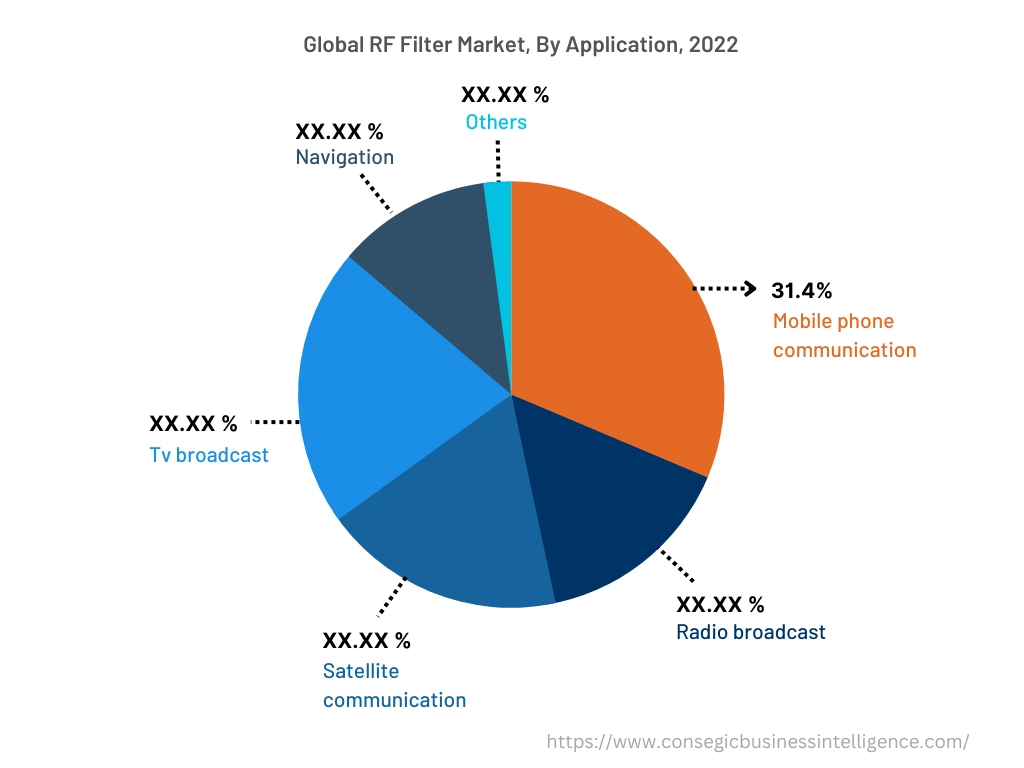
By Region :
The regional segment includes North America, Europe, Asia Pacific, Middle East and Africa, and Latin America.
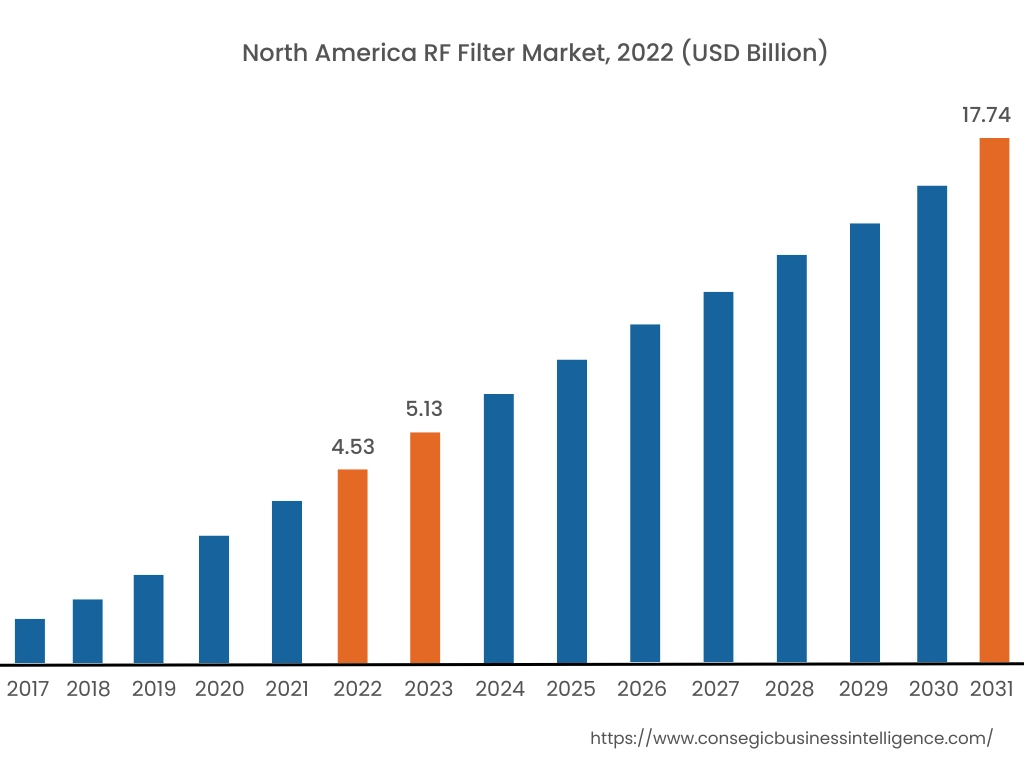
North America accounted for the largest revenue share of USD 4.53 Billion in 2022 and is expected to reach USD 17.74 Billion by 2031, growing by a CAGR of 16.8%. In addition, in the region, the U.S. accounted for the maximum revenue share of 55.35% in the same year.
The RF filter market analysis shows that the adoption of these filters in North America is primarily driven by factors including the development of new technologies, the adoption of 5G networks, and increasing demand for wireless devices, among others. North America has a well-developed and robust communication infrastructure, which provides a foundation for the adoption of these filters. The existing infrastructure is readily suitable for upgrading to accommodate these filters coupled with the presence of key players including Murata Manufacturing, Qorvo, and Analog Devices. In addition, the North American regulatory environment is supportive of the adoption of these filters to ensure the safety and reliability of these filters tends to be driving the RF filter market trends.
Moreover, Asia-Pacific is expected to register the fastest CAGR growth of 17.0% during the forecast period. The RF filter market in the Asia-Pacific region is expected to grow significantly during the forecast period. The growth is attributed to several factors, including growing demand for improved telecommunication infrastructure, healthcare support, satellite communications, broadband service, and among others. The Asia Pacific region is urbanizing rapidly, resulting in massive demand for better infrastructure in all aspects thus leading to rising the RF filter market trends.
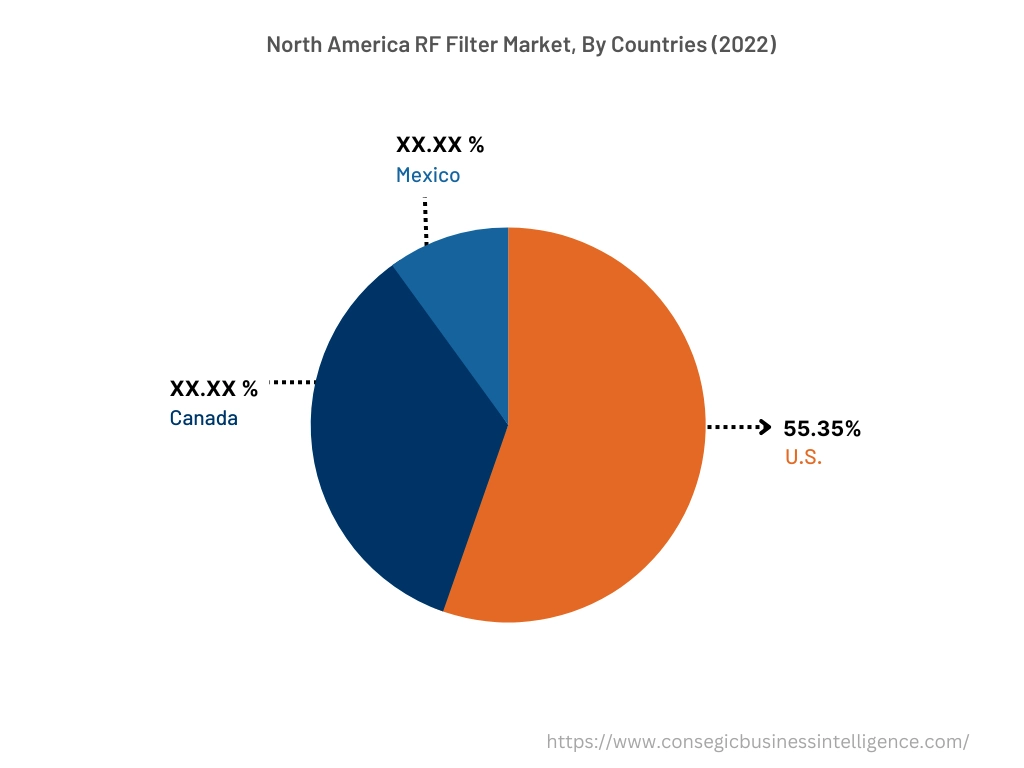
Top Key Players & Market Share Insights :
The global RF filter market is highly competitive with major players providing RF filters to the national and international markets. Key players are adopting several strategies in research and development (R&D), product innovation, and end-use launches to hold a strong position in the RF filter market. Key players in the RF filter industry include-
- Qorvo Inc.
- Anatech Electronics Inc.
- Kyocera Corp.
- Murata Manufacturing Co. Ltd.
- TDK Corp.
- Tai SAW Technology Co. Ltd.
- RS Microwave Co. Inc.
- Crystek Corp.
- Avnet Inc.
- Skyworks Solutions Inc.
- Qualcomm Inc.
- Broadcom Inc.
- CTS Corp.
- Analog Devices Inc.
Recent Industry Developments :
- In October 2021, Qualcomm Technologies, Inc. announced the launch of Qualcomm ultraBAW RF filter technology for bands up to 7 GHz, to increase the performance of 5G devices and wireless product connectivity.
- In April 2023, Koustis Technologies, Inc. announced to development of two new Wi-Fi 6E and Wi-Fi 7 XBAW filter solutions for integration into the front-end modules.
Key Questions Answered in the Report
What is RF Filter? +
An RF filter is a passive form of filter designed to receive radio frequencies and allows to pass signals within a specified frequency band and reject signals outside of the band. RF filters are used in a wide variety of applications, including radio receivers, transmitters, cellular phones, radar systems, and microwave ovens.
What specific segmentation details are covered in the RF filter report, and how is the dominating segment impacting the market growth? +
For instance, by type segment has witnessed bandpass filter as the dominating segment in the year 2022, owing to their ability to reject signals within a specified frequency band and pass signals outside of the band.
What specific segmentation details are covered in the RF filter market report, and how is the fastest segment anticipated to impact the market growth? +
For instance, by application segment will witness mobile phone communication segment to grow at the fastest growth rate during the forecast period. The increasing use of wireless devices and the development of new wireless technologies, such as 5G will drive the market growth during the forecast period.
Which region/country is anticipated to witness the highest CAGR during the forecast period, 2023-2031? +
Asia-Pacific is anticipated to register fastest CAGR growth during the forecast period due to rapid pace of industrialization and demand for improved telecommunication infrastructure.
